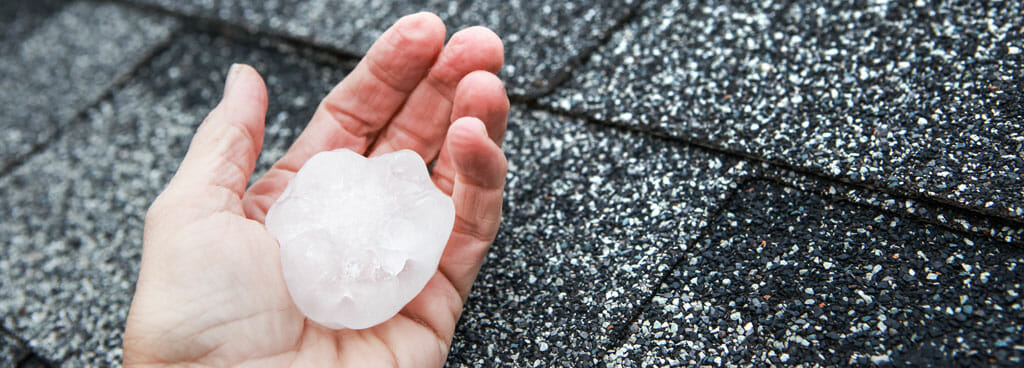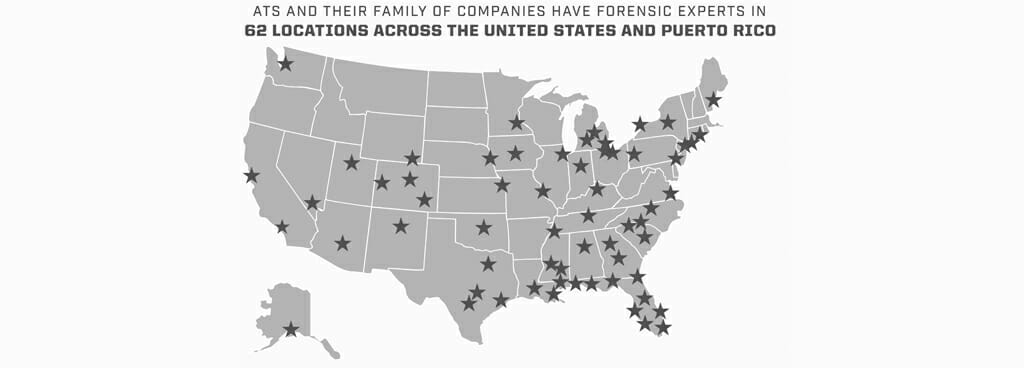- Home
- Services/IndustriesServicesindustries
- About Us
- LocationsStatesAccordion ContentAccordion ContentAccordion ContentAccordion Content
- Job Openings
- Quick Links
- ATS Family

Hail Damage Roof Inspection
The Applied Technical Services (ATS) Family of Companies conducts conclusive hail damage roof inspections for clients who experience the effects of a hailstorm.
How Hailstones Form
Hail is solid precipitation consisting of balls or irregular lumps known as hailstones. Hailstone formation requires environments with strong, upward motions of air that accumulate in parent thunderstorms and lowered heights of freezing levels.
Hailstones fall at higher speeds as their size grows. Complicated factors—such as melting, interaction with rain, interference from other hailstones, and friction with air—can slow hailstones as they descend to Earth. When the hailstones reach a particular size, they can cause damage to human-made structures.
The Effects of Hailstorms
Hail can result in either functional or cosmetic damage to properties. Functional hail damages affect the longevity and integrity of a roof, while cosmetic hail damages only affect its appearance. These damages can range from small cracks to significant splits and tears.
Although hailstorms might not be devastating natural disasters, they have the potential to cause considerable damages that require costly repairs. The damage hailstorms cause depends on multiple factors, such as the size of the hail, speed and direction of the wind, material of the structure, age of the structure, slope of the roof, and quality of construction.
Understanding the Size of Hail and Its Impact
The size of hail indicates the extent of damage a roof obtains after a hailstorm. Though not the only factor in understanding the possible effects, it is a significant starting point.
Hail Sizes and Effects:
3/4″ hail is the smallest size of hail that can cause property damage. Depending on the wind speed, it can cause harm to the gutters, windows, siding, paint on decks, and the granule surface of shingles.
1″ hail may cause bruises to the underlayment of shingles. It can also cause harm to the gutters, siding, fascia, and other roof components. Wind speed is an essential factor in determining the extent of roof damage.
1 ¼” – 1 ½” hail can cause significant damage. The damage’s extent depends on the storm’s duration and wind speed.
1 ¾” – 2″ hail can not only pierce through the softer parts of a roof, but also tear off siding, break windows, crack tiles, and damage metal fixtures.
2″ sizes and above of hail can be extremely serious, causing severe damage to properties. If this size of hail hits a property, it must undergo an emergency inspection and receive professional repairs.
How Hail Damage Roof Inspection Works
A property owner may need emergency repairs on their roof depending on the extent of the damage sustained during the hailstorm. Some signs of the storm are apparent, such as broken windows, missing tiles, or large dents.
Licensed professionals will need to inspect the roof to gauge the severity of the damage. Once they assess the area, they can create an in-depth report of all their findings, deciding whether a client requires minimal repairs or a complete roof replacement.
Our Roof Damage Evaluations
Our team of experts inspects commercial roofing to determine the cause and origin of damages. We first identify whether the damage resulted from a construction defect, material failure, third-party contribution, or lack of maintenance. Once we find the cause, our team of experts will supply clients with a report outlining the extent of damage and the suggested method of repair.
Our Licensed Professionals
Our Family of Companies offers structural damage evaluations by our licensed team of Professional Engineers (P.E.s). Many of our engineers hold memberships with various organizations, such as the ASCE (American Society of Civil Engineers) and the NAFE (National Academy of Forensic Engineers).
Contact Us
Contact the ATS Family of Companies today if you have questions or need to schedule a hail damage roof inspection.


Request Form
"*" indicates required fields
Forensic Services
- 3D Laser Scanning
- Accident Reconstruction
- Accident Reconstruction Animation
- Accident Reconstruction Engineering
- Accident Reconstruction Experts
- Accident Reconstruction Services
- ACTAR - Traffic Accident Reconstructionist
- Arc Mapping
- Arson Investigators
- Asbestos Testing Lab
- Automotive Expert Witness
- Black Box Data
- Boilers, Vessels & Piping Failure Analysis
- Bosch Crash Data Retrieval
- Certified Arson Investigator
- Certified Fire Investigator
- Certified Forensic Expert
- Climate-Controlled Evidence Storage
- Construction Defect Expert Witness
- Construction Equipment Expert Witness
- Construction Expert Witness
- Crash reconstruction
- EDR Event Data Recorder Analyst
- Electrical Forensic Analysis
- Electrical Forensics
- Elevator Expert Witness
- Elevator Inspections
- Event Data Recorders
- Evidence Storage
- Evidence Storage Services
- Expert Witness Companies
- Expert Witness Services
- Explosion Investigations
- Farm Fire
- Fire Cause Analysis
- Fire Cause Investigation
- Fire Debris Analysis
- Fire Forensic Data Collection
- Fire & Forensic Investigation Updates
- Fire Investigation Company
- Fire Investigation Companies
- Fire Investigation Services
- Fire Investigator
- Fire Investigator Atlanta, GA
- Fire Investigation Expert Witness
- Fire Retardant Standards
- Fire Scene Investigaton
- Fire Scene Investigators
- Firearms Testing
- Forensic 3-D Site Scanning Service
- Forensic 3-D Scanning
- Forensic Accident Reconstruction
- Forensic Assignment Form
- Forensic Building Consultants
- Forensic Chemical Analysis
- Forensic Construction Expert
- Forensic Crash Specialists
- Forensic Electrical Engineer
- Forensic Engineering Consultants
- Forensic Engineering Expert
- Forensic Engineering Expert Witness
- Forensic Expert Witness
- Forensic Fire and Explosion Investigators
- Forensic Fire Investigation
- Forensic Fire Investigations
- Forensic Fire Investigation Services
- Forensic Imaging Specialist
- Forensic Lab Testing
- Forensic Locksmith
- Forensic Metallurgist
- Forensic Metallurgy
- Forensic Specialist
- Forensic Structural Engineer
- Forensic Structural Engineering
- Forensic Structural Engineering Firms
- Forensic Testing Service
- Forensic Thermal Imaging
- Forensic Tire Expert
- Forensic Water Damage Evaluation
- Forklift Expert Witness
- Golf Cart Expert Witness
- HAAG Certified
- Hail Damage Roof Inspection
- Handgun Testing
- Hurricane Structural Damage Evaluation
- Hurricane Structural Damage Inspection
- IAAI Certified Fire Investigator
- Incident Reconstruction
- Industrial Accident Investigation
- Infrared Thermal Imaging Services
- Joint Inspections
- Lap Shear Testing
- Large Loss
- Litigation Expert Witness
- Litigation Support
- Maritime Expert Witness
- Mechanical Forensics
- Natural Disaster Inspections
- Precision Forensic Testing
- Product Liability Expert
- Product Liability Expert Witness
- Secured Evidence Storage
- Special Services
- Speed Control Deactivation
- Structural Analysis
- Structural Fire Damage Assessment
- Structural Investigation
- Tire Failure Expert
- Traffic Accident Reconstruction
- Thermal Imaging
- Thermal Imaging Services
- Traffic Accident Reconstruction
- Truck Accident Expert Witness
- UTV/ATV Expert Witness
- Vehicle Fire Investigations
- Water Damage Inspection
